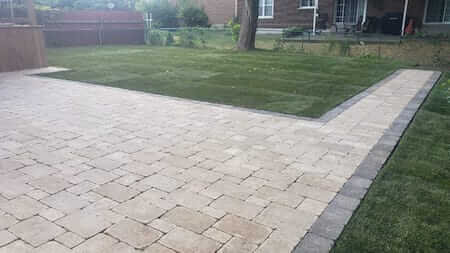What is Hardscaping and how can it benefit your home?
If you’re planning to transform your outdoor space into a beautiful, functional, and inviting area, you might have heard of the term “hardscaping.” But what exactly is hardscaping? In this blog post, we will define hardscaping, explain its importance, and provide some examples to give you a better understanding of this landscaping term.
What is Hardscaping?
Hardscaping refers to the non-living or man-made features in a landscape design. It includes all the elements of your outdoor space that are not plants, such as patios, walkways, retaining walls, fences, water features, fire pits, and outdoor kitchens. In contrast, softscaping refers to the living elements in a landscape design, including plants, trees, and flowers.
Hardscaping is an essential part of any outdoor design because it provides the structural foundation and functional elements that support and enhance your landscaping. For instance, a beautifully manicured garden will look even better with an elegant patio or an inviting walkway that complements its style and theme. Likewise, a spacious outdoor kitchen will make your backyard the perfect spot for entertaining friends and family while enjoying the fresh air and beautiful scenery.
The Importance of Hardscaping
Hardscaping has several benefits that make it a crucial part of any landscaping project. Here are some of the reasons why hardscaping is so important:
1. Increases Property Value
Hardscaping can significantly increase the value of your property. When you add functional and visually appealing features to your outdoor space, it becomes more attractive and desirable to potential buyers. According to a survey by the National Association of Realtors, hardscaping projects like patios, fire pits, and outdoor kitchens have a high return on investment, with an average of 55% to 75% of the cost recovered at resale.
2. Low Maintenance
Hardscaping features require minimal maintenance compared to plants and trees. They don’t need watering, pruning, or fertilizing, which makes them more cost-effective and less time-consuming. Additionally, hardscaping can protect your softscaping by providing drainage, erosion control, and support to your plants and trees.
3. Increases Functionality
Hardscaping can make your outdoor space more functional and versatile. For instance, a patio can be used for dining, entertaining, or relaxation. A retaining wall can provide additional seating or act as a planter for your favorite flowers. An outdoor kitchen can turn your backyard into a full-service restaurant where you can cook, serve, and entertain your guests.
4. Adds Visual Appeal
Hardscaping features can add beauty and style to your landscape design. From elegant pavers to unique water features, hardscaping can create a stunning visual impact that complements your softscaping and enhances the overall aesthetic appeal of your outdoor space.
Examples of Hardscaping Features
Now that you understand what hardscaping is and why it’s important, let’s look at some common hardscaping features that you can add to your outdoor space.
1. Patios
A patio is a flat, paved area that is often used for outdoor dining, entertainment, or relaxation. Patios can be made of a variety of materials, including concrete, pavers, bricks, or natural stone. They can be designed in a variety of shapes and sizes, depending on your needs and preferences. Patios can also be enhanced with decorative elements, such as fire pits, water features, or outdoor lighting.
2. Walkways
Walkways are a great way to add functionality and style to your outdoor space. They can be made of concrete, pavers, bricks, or natural stone, and can be designed in a variety of shapes and patterns.
Walkways not only provide a safe and easy way to navigate through your garden or yard but also create a visual interest that enhances the overall look of your landscape design. You can also incorporate features like lighting or edging to make your walkway even more visually appealing.
3. Retaining Walls
Retaining walls are designed to hold back soil and prevent erosion in sloped or uneven areas. They can also be used to create additional seating or planters for your garden. Retaining walls can be made of various materials, including concrete, brick, or natural stone, and can be designed in various shapes and sizes to complement the style of your landscape design.
4. Fences
Fences can provide privacy, security, and style to your outdoor space. They can be made of a variety of materials, including wood, vinyl, aluminum, or wrought iron. Fences can be designed in various heights, styles, and patterns to complement your landscape design and enhance the aesthetic appeal of your property.
5. Water Features
Water features, such as fountains, ponds, or waterfalls, can add a soothing and tranquil ambiance to your outdoor space. Water features can be designed in various shapes and sizes and can be made of various materials, including stone, concrete, or metal. They can be integrated into your landscape design to create a focal point that enhances the visual appeal of your garden or yard.
6. Outdoor Kitchens
Outdoor kitchens are perfect for those who love to entertain and cook outdoors. They can be designed to include a range of features, including a grill, sink, refrigerator, and storage. Outdoor kitchens can be made of various materials, such as concrete, brick, or natural stone, and can be designed to complement the style of your landscape design.
7. Fire Pits
Fire pits are great for those who love to spend time outdoors and entertain guests. They can be designed in various shapes and sizes and can be made of various materials, including natural stone, brick, or metal. Fire pits can add warmth and light to your outdoor space, creating a cozy and inviting ambiance for your guests.
Conclusion
In conclusion, hardscaping is an essential part of any landscape design. It provides the structural foundation and functional elements that support and enhance your softscaping. Hardscaping features can add visual appeal, functionality, and value to your property, and require minimal maintenance. Whether you’re looking to create an inviting patio, an elegant water feature, or a functional outdoor kitchen, hardscaping can transform your outdoor space into a beautiful and functional area that you can enjoy for years to come.
If you are interested in finding out more about our hardscaping services please contact us and schedule your free consultation today.

